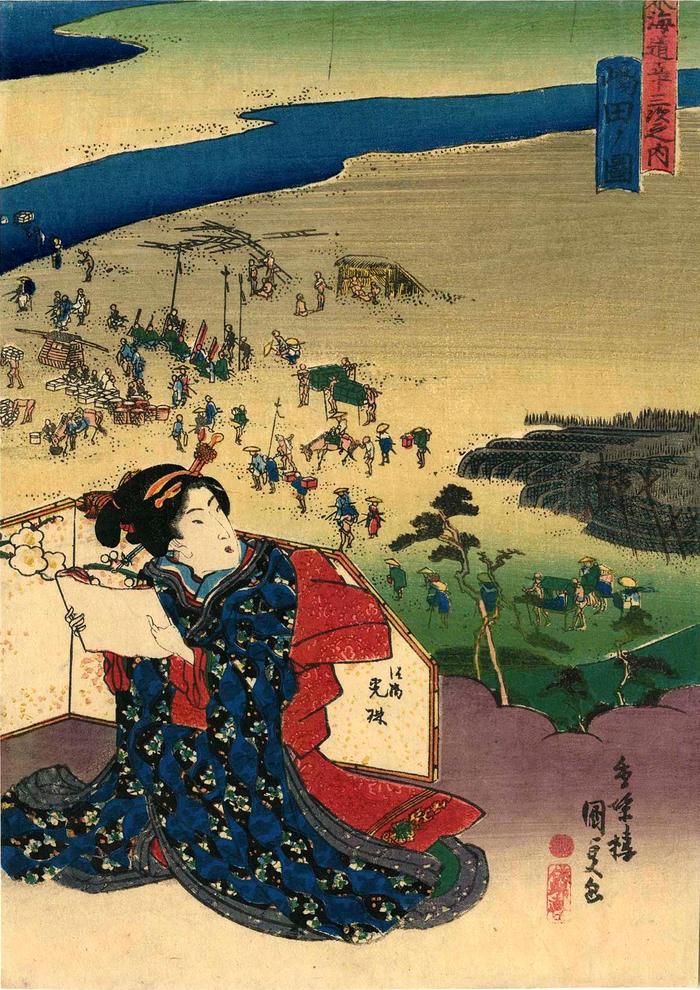Utagawa Kunisada (歌川国貞) / Toyokuni III (三代豊国) (artist 1786 – 01/12/1865)
View of Shimada (Shimada no zu: 嶋田ノ図) from the series Fifty-three Stations of the Tōkaidō Road (Tōkaidō gojūsan tsugi no uchi: 東海道五十三次之内)
ca 1838
Signed: Kōchōrō Kunisada ga (香蝶楼国貞画)
Publisher: Sanoya Kihei
Censor's seal: kiwame
Museum of Fine Arts, Boston
National Diet Library
Spencer Museum of Art
British Museum - Hiroshige's 'Shimada Oi-gawa Sungan (Shimada: The Suruga Bank of the Oi River)'
Museum für angewandte Kunst, Vienna
Virginia Museum of Fine Art
Ishikawa Prefectural Museum of Art - they date their copy to 1836
Bryn Mawr
Honolulu Museum of Art
The Library of Congress
Fujisawa Ukiyo-e Museum
Victoria and Albert Museum
Nelson-Atkins Museum of Art All of the prints in this series are chūban sized. The example of this print in the collection of the Museum of Fine Arts in Boston is 9 13/16 x 7 5/16 in. This one in the Lyon Collection is fractionally smaller because it has been trimmed slightly at the top and along the left hand side.
****
This is number 24 in the series. With the exception of the woman distracted from reading a letter, Kunisada has stayed very close to the model set by Hiroshige's print.
****
In Tokaido Landscapes: The Path from Hiroshige to Contemporary Artists, 2011, #24, p. 36, speaking of the original Hiroshige print it says in a text by Sasaki Moritoshi: "The Ōi River, one of the most dangerous spots on the Tōkaidō, could only be crossed on foot. The east bank was in Suruga Province, and the far bank was in Tōtōmi Province. Depicted are a daimyo's procession and the porters who will carry it across the river; more than a hundred people are in the print, drawn from a bird's-eye view. Though the figures of the people are quite small, the variety with which they are depicted is remarkable."
****
In Hiroshige: l'art du voyage, Paris, 2012, p. 73 it says: "Lors des hautes eaux, il fallait souvent patienter des jours, voire des semaines, avant de pouvoir traverser - sur les dos d'un passeur professionnel ou sur des plateformes que portaient plusieurs passeurs. Le prix dépendait de la hauteur des eaux. Le fleuve séparait les provinces de Suruga et de Tōtōmi."
****
In the entry on the Kanaya station in Tōkaidō Texts and Tales: Tōkaidō gojūsan tsui by Kuniyoshi, Hiroshige, and Kunisada, edited by Andreas Marks, University Press of Florida, 2015, it describes on page 91 a woman being transported across the Ōi River. "The print depicts a young woman with a Shimada-mage, a back-looped pile fastened with a comb, which was one of the most popular hairstyles among unmarried Japanese women at that time. This style is said to have originated with women entertainers at the post station of Shimada, where this woman seems to be traveling from."
****
In Hokusai and Hiroshige: Great Japanese Prints from the James A. Michener Collection, Honolulu Academy of Arts on page 1867 it says: "In the Edo period, in accordance with the shogunate's strategy for preserving the safety of the capital, construction of bridges over large rivers was not permitted. These unbridged rivers thus remained formidable impediments to moving hostile troops rapidly, making it difficult for enemy forces to attack the capital by surprise.
In places where the river was safe to cross, coolies were available for hire, to carry travelers in palanquins, on a platform, or piggyback. There were fixed rates for these different means of transport, and the level of he water was calculated in the price, which increased according to whether it was up to the knees, waist, chest, or shoulders."
****
Illustrated in a small color reproduction in Kunisada's Tokaido: Riddles in Japanese Woodblock Prints by Andreas Marks, Hotei Publishing, 2013, page 68, T24-24.
Sanoya Kihei (佐野屋喜兵衛) (publisher)
landscape prints (fūkeiga 風景画) (genre)
beautiful woman picture (bijin-ga - 美人画) (genre)
